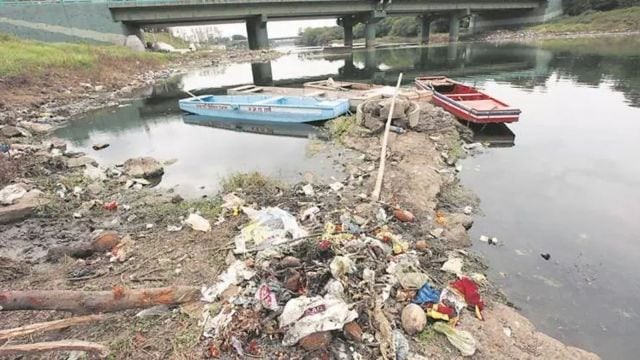River Pollution in India

- 27 Sep 2025
In News:
Rivers are the lifelines of India, sustaining agriculture, industry, and millions of livelihoods. Yet, rapid urbanisation, untreated sewage, industrial effluents, and agricultural runoff have severely degraded many river ecosystems. According to the Central Pollution Control Board (CPCB), river pollution remains a critical environmental and public health challenge.
Status of River Pollution
The CPCB’s 2023 assessment indicates a marginal reduction in polluted river stretches. Out of 271 rivers across 32 states and Union Territories, 296 stretches were identified as polluted, down from 311 in the previous assessment. Maharashtra continues to report the highest number of polluted stretches (54), followed by Kerala (31), Madhya Pradesh and Manipur (18 each), and Karnataka (14).
Polluted stretches are defined as two or more consecutive locations where the biochemical oxygen demand (BOD) exceeds 3 mg/L, rendering water unfit for bathing. BOD measures the oxygen consumed by microorganisms in decomposing organic matter, serving as a key indicator of organic pollution. The CPCB classifies polluted stretches into five priority categories, with Priority I (BOD >30 mg/L) representing the most contaminated stretches requiring urgent remediation. Currently, 37 stretches fall under Priority I, including the Yamuna (Delhi), Sabarmati (Ahmedabad), Chambal (Madhya Pradesh), and Tungabhadra (Karnataka).
However, despite marginal improvements, certain rivers have recorded deterioration in water quality. Notable examples include the Jhelum (J&K), Ganga and Sikrahna (Bihar), Hasdeo and Mahanadi (Chhattisgarh), Cauvery and Tungabhadra (Karnataka), Periyar (Kerala), and Krishna (Telangana).
Major Causes
- Untreated Sewage: Urban centres generate over 72,000 million litres/day (MLD) of sewage, with only 30% treated.
- Industrial Effluents: Chemical, textile, and other industrial hubs discharge toxic waste despite regulatory frameworks.
- Agricultural Runoff: Fertilisers and pesticides enter rivers during monsoons, affecting aquatic ecosystems.
- Encroachments and Sand Mining: These activities degrade riverbeds and floodplains, compounding pollution impacts.
Impacts
Polluted rivers compromise aquatic biodiversity, pose health risks via waterborne diseases, and lead to economic losses in fisheries and agriculture. Social unrest, as seen along the Yamuna and Ganga, underscores the public concern over deteriorating river health.
Institutional Interventions
In 2018, the National Green Tribunal (NGT) mandated states and the Centre to prepare river rejuvenation action plans. The CPCB, in collaboration with State Pollution Control Boards, monitors water quality at over 2,155 locations on 645 rivers under the National Water Quality Monitoring Programme. Recommended measures include catchment and basin management, floodplain protection, and sewage treatment.
While initiatives such as the Namami Gange Mission, Jal Jeevan Mission, and promotion of decentralised sewage treatment plants show progress, persistent infrastructure gaps, coordination failures, and urbanisation pressures remain major challenges.
Way Forward
Sustainable river rejuvenation requires holistic approaches—strengthening sewage treatment, enforcing industrial compliance, controlling agricultural runoff, and fostering community participation. Integrating scientific monitoring with participatory governance can help restore rivers as ecological lifelines while ensuring water security, public health, and environmental sustainability.
